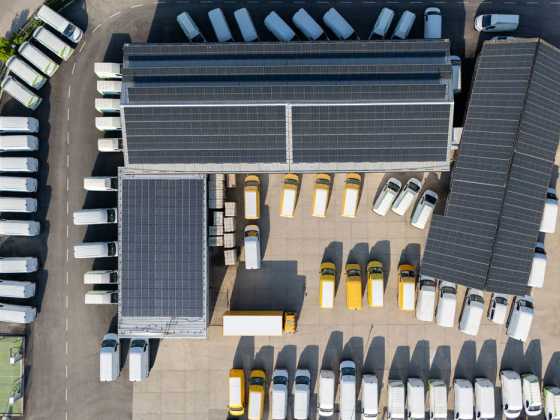Sustainable fleet procurement

Despite what has already been achieved by many fleets, it can still be a daunting task to start on the road to electrification. Kim Harrison explains how the Crown Commercial Service can help public sector fleets access solutions to meet their sustainability targets
The UK government recently set out its ambition to bring forward phasing-out sales of new internal combustion engines from 2040 to 2030. The approach will mean that new cars and vans sold between 2030 and 2035 will have to be capable of “significant” mileage on zero emissions, such as plug-in or full hybrids. By 2035, all new cars and vans will need to be fully zero-emission at the tailpipe.
Vehicles are part of a wide-reaching programme to deliver carbon net-zero for the country, and there is a range of initiatives to support this. Despite representing only around 7% of the fleet on UK roads, the public sector plays a central role in this green ambition. We have the chance to widen the positive impact on supply chains while providing a responsible role model to lead others.
Good commercial practice
As set out in the 2017 Budget and included within Government Buying Standards, central government departments are responsible for meeting the Government Fleet Commitment of electrifying 25 per cent of car fleets by 2022.
At Crown Commercial Service (CCS), we work closely with the Office for Zero Emission Vehicles (OZEV) to ensure the public sector achieves the best possible commercial solutions for its fleet. We provide routes to market while also directly liaising with the supply market and trade representatives for the full range of goods and services.
Our team of category experts has a wealth of public sector fleet experience. As such, we understand the fleet needs across the public sector are hugely varied - from requiring pooled vehicles for office-based staff to front-line emergency service vehicles, there is no one-size-fits-all solution.
We aim to use our industry experience, insight and strategic vision to interpret the possibilities for sectors or individual fleets across the public sector. To deliver this, we harness relationships with suppliers and trade bodies, and access to other market intelligence, and create opportunities for discussion and networking across our customer base.
The landscape
Through our commercial agreements, we know more than 35,000 vehicles are replaced by public sector fleets each year. So far this financial year, we have seen 4,880 electric vehicles taken up by our customers, representing an incredible 518 per cent increase on last year’s number - it’s very much the start of something.
This data signals the move to less polluting vehicles has passed the early adoption phase and if this rate of change continues, we’ll see an early-majority opting for this technology.
Out in the wider world, the BVRLA forecast that by 2023, electric vehicles will make up 14 per cent of cars on the road, and hybrids taking an even share with petrol and diesel, as the latter two are being phased out.
We know that this change has been driven by legislation - such as change in testing regimes from NEDC to WLTP and Euro 6 engine standards. Regulation has also played a part - for example, certain sectors have been required to change their fleet profile. Finally, policy has also been key, with the government continuing to invest in incentives expanding the public and private vehicle charging infrastructure.
The real impetus, however, has been caused by the supply markets. They have invested in new technologies, brought them to market and created the consumer appetite for the products.
Where to start
Despite what has already been achieved by many fleets, it can still be a daunting task to start on the road to electrification. CCS has commercial arrangements covering a range of products and services to help you access the right solutions at the right time.
To plan for the future, you need to understand the present. The first step on the sustainability journey is developing a clear understanding of how your fleet is being used.
Our Vehicle Telematics: Hardware and Software Solutions agreement provides fleet managers with everything they need to support decision-making, operational management and inform fleet policy.
Telematics can capture data on journey frequency, mileage, service, repair and replacement cycles, along with driver behaviour. How your drivers drive has a direct impact on emissions, fuel consumption and vehicle damage. This data can be coupled with reports from hired vehicles and grey fleet to create a wholistic approach view on an organisation’s mobility.
If the expertise is not readily available in-house, our Vehicle Lease and Fleet Management agreement can help you understand how your fleet is used. It provides access to independent fleet management companies with the skills and knowledge to help interpret the data.
Create a strategy
Once you understand your current usage, you can begin to plan for the future. The electrification of your fleet is a programme of change and like managing any other change programme, stakeholder engagement is key. Keeping all interested parties engaged and informed from the earliest possible moment is the best route to ensuring their buy-in as you evolve your strategy.
In addition to engaging with employees, it’s vital that you consult with your sustainability, finance and property teams. HR will also be an important partner if you’re considering options such as vehicle salary sacrifice schemes.
Your strategy will need to include a vision for your vehicle charging infrastructure. A common trap is eagerly ordering ULEVs before determining the charging solution.
A potential quick win on this front is with home charging. It’s relatively easy to implement and our Vehicle Lease, Fleet Management and Flexible Rental agreement offers solutions such as home charging kits and installations that can even be built into an employee's car salary sacrifice plan.
Work-based charging can be more challenging. You must decide whether you want a closed network for use by business vehicles only, whether you want staff to be able to access on a pay-as-you-go basis, or indeed if you would want to open access to the general public with an income generation model.
Our Vehicle Charging Infrastructure Solutions agreement is designed to help you develop a viable charging infrastructure, offering services including consultancy and feasibility, groundworks, civil engineering and construction, hardware and installation, software and back-office solutions, through to a full end-to-end service.
An area not to be overlooked is provision of means for payment for refuelling. For this, our Fuel Cards and Associated Services and National Fuels agreements provide mechanisms to source and pay for alternative fuels of all kinds. The suppliers on these agreements have access to over 7,000 electric charging points and use of seven locations from where hydrogen can be purchased.
Fleet should be considered as part of a business’s total mobility plan, and if the aim is to reduce carbon, the best action is to reduce travel altogether. Where staff still need to travel, a strategy cannot ignore the option of employees using their own vehicles, known as grey fleet.
Effectively managing grey fleet usage can dramatically reduce the carbon footprint of your organisation's business travel as well as reducing the associated occupational road risk. Employees' vehicles are often older and give off higher emissions. There’s also an added risk to employers, as they have to ensure they are adequately insured and maintained in a roadworthy state.
Salary Sacrifice schemes are a tried and tested method of providing a new, cost-effective and low-emission vehicle to employees while reducing an organisation’s carbon footprint. Green vehicle salary sacrifice schemes, and indeed car clubs, can effectively reduce emissions and improve staff retention. The low Benefit in Kind taxation associated with salary sacrifice schemes makes them extremely attractive to employees while, for the employer, they can be run on a cost-neutral basis.
Lot 3 of our Vehicle Lease, Fleet Management & Flexible Rental agreement provides independent fleet management companies who offer salary sacrifice schemes. They can manage the whole process, from implementation to ongoing management. We also have a dedicated Lot on our Vehicle Hire Solutions agreement for car club provision, providing access to suppliers who specialise in this.
Achieve great things
Armed with your data, analysis and a comprehensive strategy, you are ready to move your fleet to lower polluting vehicles and make a real difference. Bring your stakeholders with you on every step of the journey and continue to review the data to sense check that what you are doing is giving the results you expected.
As with any market, things don’t stay static so it’s important to try to keep best informed on new ways of doing things, new products and services available.
For this reason, we strongly recommend you remain engaged with your supply chain so you can ensure early sight of their future strategies. Our team of category experts are also here to help you in this area.
We work closely with organisations such as the Energy Savings Trust, Office for Zero Emission Vehicles and the Society of Motor Manufacturers & Traders, as well as our supply chain partners, to gain insight and continually update our category strategies to ensure they are future-proofed.
Finally, the CCS Fleet Portal is a key tool that can help you identify the latest vehicles available in the market. It provides access to all vehicles available in the UK market and, by using the filtering systems, it’s easy to identify those vehicles that meet your fleet policy criteria. The competitive quoting functionality can also ensure that our customers obtain value for money and are sighted on the whole life costs when comparing different vehicles.
Next steps
Wherever you are on the journey, every step you take moves you closer to reducing the carbon footprint of your fleet operations and road-related business travel.
We recognise this is a challenging project for any fleet manager, which is why we’ve created a new web page explaining how we can help you meet your sustainability targets across the whole fleet lifecycle.
Written by Kim Harrison, category lead for fleet at Crown Commercial Service






